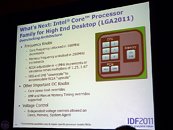Saturday, September 24th 2011

How To Overclock a Locked New Sandy Bridge E Processor - By Intel
We know how chip manufacturers aren't usually very keen on overclocking of their products, but here, Intel explains the actual steps to take in achieving a great overclock! And oddly enough, this includes their locked CPUs as well, which raises the question of why lock them at all? Bit-tech looked into overclocking the new LGA2011 Sandy Bridge E in detail.Intel highlights the key areas for overclocking Sandy Bridge E processors, and gives a practical example of a 4.74 GHz overclock
Here are the basics:
- Locked CPUs can be overclocked too
- SB-E has more flexible base clock overclocking, using two dividers, 1.25x & 1.66x
- You need to play with Turbo Boost to prevent power limiting from throttling the system back
- There's some scary maths to work out, for example: 1) 5,000 ÷ 1.66 = 3,012 2) 3,012 ÷ 100 = 30.012 3) 3,012 ÷ 30 = 100.4 system clock. Likely a spreadsheet would help here.
For full details, see the bit-tech article, where they work out how to push an SB-E system to a healthy 5 GHz.
Source:
bit-tech
Here are the basics:
- Locked CPUs can be overclocked too
- SB-E has more flexible base clock overclocking, using two dividers, 1.25x & 1.66x
- You need to play with Turbo Boost to prevent power limiting from throttling the system back
- There's some scary maths to work out, for example: 1) 5,000 ÷ 1.66 = 3,012 2) 3,012 ÷ 100 = 30.012 3) 3,012 ÷ 30 = 100.4 system clock. Likely a spreadsheet would help here.
For full details, see the bit-tech article, where they work out how to push an SB-E system to a healthy 5 GHz.


27 Comments on How To Overclock a Locked New Sandy Bridge E Processor - By Intel
Mind you, wild speculation can be a great pastime. :D